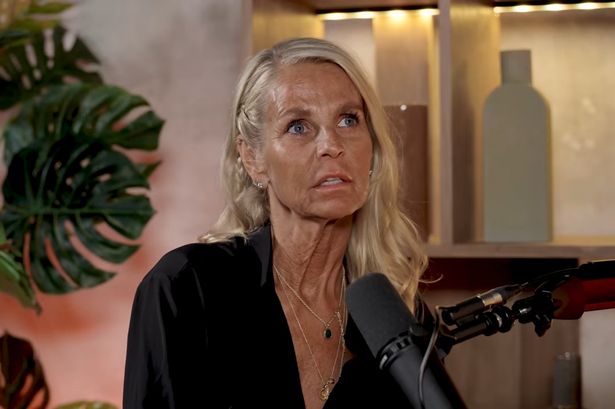Following a recent podcast, Ulrika Jonsson addressed trolls who had criticized her appearance and explained why she didn’t wear make-up.
Ulrika Jonsson has slammed trolls who targeted her following a recent podcast appearance. The TV presenter, 57, took aim at the trolls who criticised her appearance recently and called them out for their “nasy comments”.
It came after the former model appeared on Spencer Matthews’ Untapped Podcast, which is also filmed for fans to watch. Ulrika took to Instagram at the weekend to shut down any bad mouthing and had a stern message for those taking aim at her.
While Ulrika also had positive comments, some viewers felt the need to criticize her “over-tanned” and “ageing” appearance, according to Ulrika’s lengthy post. The actress, however, explained the reason behind her appearance and wasn’t willing to let them down with it.
She wrote, “I feel I need to address something,” after sharing a photo of her kissing the camera. I don’t receive many nasty comments, or if I do, I don’t respond with a loving response.
“But a couple of weeks ago I took part in a fab podcast @untapped.podcast to discuss my sobriety with the smart @spencermatthews. I wore no make-up. Partly because I kinda forgot that a project for the ears is nowadays also a feast for the eyes.
I’m not a fan, though, as someone who has had to wear heavy makeup on the big screen from 5 am for years.
She also confessed to have suffered from eczema as a child, in particularly on her body in the creases of her arms and legs. She also said she had it on her face. Therefore, make-up was “agony” to wear.“There were a lot of positive comments about the WORDS I said on the podcast,” she continued. “But a considerable amount about my tanned appearance. AND how OLD I look.“In a few weeks I will be 58. I will never look like the fresh 21yr old that used to greet you first thing in the morning by the weather board.”
She also acknowledged that she is aware of the fact that she is “probably going to” pay the price for that. However, she added that ageing won’t help her uneven pigmentation either.
Ulrika admitted in a private interview that she occasionally uses filters because it’s simpler to apply makeup on her photos. She added that she frequently spends her entire summer working in her garden, which means she gets sun.
She went on: “I rarely sunbathe any more. Haven’t had a sunbed for 6 months – which I do occasionally in winter months. Not ashamed. I have not had a holiday – of any kind – since 2018. That’s 7yrs.“So, I understand that an over-tanned, imperfect and AGEING face offends you. But try to listen to the words rather than constantly judge women’s appearance. You might learn something.”
And she came to the defiant sign-off message, saying, “And making people feel s*** doesn’t make you a hero.”
Over 20 000 people who clicked the like button gave Ulrika a warm welcome even though she turned off the comments on the post. Matt Tebbutt of Saturday Kitchen and Anna Williamson of Celebs Go Dating were just two.
Ulrika had previously discussed how sex has grown “interesting” since stopping drinking alcohol 13 months ago in a podcast. She explained how going sober could have a negative effect on her sex life, but it had helped.
And she explained how going on a date without a drink has changed her outlook: “It’s really hard because people aren’t as attractive,” she said before adding that after drinking, “you just become a little bit more available… it’s easier.












